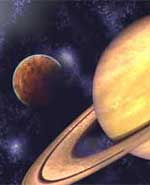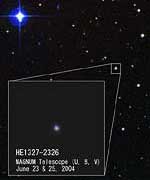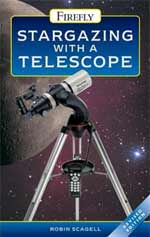
Image credit: NWU
The peculiar orbits of three planets looping around a faraway star can be explained only if an unseen fourth planet blundered through and knocked them out of their circular orbits, according to a new study by researchers at the University of California, Berkeley, and Northwestern University.
The conclusion is based on computer extrapolations from 13 years of observations of planet motions around the star Upsilon Andromedae. It suggests that the non-circular and often highly elliptical orbits of many of the extrasolar planets discovered to date may be the result of planets scattering off one another. In such a scenario, the perturbing planet could be shot out of the system entirely or could be kicked into a far-off orbit, leaving the inner planets with eccentric orbits.
“This is probably one of the two or three extrasolar systems that have the best observations and tightest constraints, and it tells a unique story,” said Eric Ford, a Miller postdoctoral fellow at UC Berkeley. “Our explanation is that the outer planet’s original orbit was circular, but it got this sudden kick that permanently changed its orbit to being highly eccentric. To provide that kick, we’ve hypothesized that there was an additional planet that we don’t see now. We believe we now understand how this system works.”
If such a planet had caromed through our solar system early in its history, the researchers noted, the inner planets might not now have such nicely circular orbits, and, based on current assumptions about the origins of life, Earth’s climate might have fluctuated too much for life to have arisen.
“While the planets in our solar system remain stable for billions of years, that wasn’t the case for the planets orbiting Upsilon Andromedae,” Ford said. “While those planets might have formed similarly to Jupiter and Saturn, their current orbits were sculpted by a late phase of chaotic and violent interactions.”
According to Ford’s colleague, Frederic A. Rasio, associate professor of physics and astronomy at Northwestern, “Our results show that a simple mechanism, often called ‘planet-planet scattering’ – a sort of slingshot effect due to the sudden gravitational pull between two planets when they come very near each other – must be responsible for the highly eccentric orbits observed in the Upsilon Andromedae system. We believe planet-planet scattering occurred frequently in extrasolar planetary systems, not just this one, resulting from strong instabilities. So, while planetary systems around other stars may be common, the kinds of systems that could support life, which, like our solar system, presumably must remain stable over very long time scales, may not be so common.”
The computer simulations are reported in the April 14 issue of the journal Nature by Ford, Rasio and Verene Lystad, an undergraduate student majoring in physics at Northwestern. Ford was a student of Rasio’s at the Massachusetts Institute of Technology before pursuing graduate studies at Princeton University and arriving at UC Berkeley in 2004.
The planetary system around Upsilon Andromedae is one of the most studied of the 160-some systems with planets discovered so far outside our own solar system. The inner planet, a “hot Jupiter” so close to the star that its orbit is only a few days, was discovered in 1996 by UC Berkeley’s Geoff Marcy and his planet-hunting team. The two outer planets, with elongated orbits that perturb each other strongly, were discovered in 1999. These three, huge, Jupiter-like planets around Upsilon Andromedae comprised the first extrasolar multi-planet system discovered by Doppler spectroscopy.
Because of the unusual nature of the planetary orbits around Upsilon Andromedae, Marcy and his team have studied it intensely, making nearly 500 observations – 10 times more than for most other extrasolar planets that have been found. These observations, the wobbles in the star’s motion induced by the orbiting planets, allow a very precise charting of the planets’ motions around the star.
“The observations are so precise that we can watch and predict what will happen for tens of thousands of years in the future,” Ford said.
Today, while the innermost planet huddles close to the star, the two outer planets orbit in egg-shaped orbits. Computer simulations of past and future orbital changes showed, however, that the outer planets are engaged in a repetitive dance that, once every 7,000 years, brings the orbit of the middle planet to a circle.
“That property of returning to a very circular orbit is quite remarkable and generally doesn’t happen,” Ford said. “The natural explanation is that they were once both in circular orbits, and one got a big kick that caused it to become eccentric. Then, the subsequent evolution caused the other planet to grow its eccentricity, but because of the conservation of energy and angular momentum, it returns periodically to a very nearly circular orbit.”
Previously, astronomers had proposed two possible scenarios for the formation of Upsilon Andromedae’s planet system, but the observational data was not yet sufficient to distinguish the two models. Another astronomer, Renu Malhotra at the University of Arizona, had previously suggested that planet-planet scattering might have excited the eccentricities in Upsilon Andromedae. But an alternative explanation claimed that interactions among the planets and a gas disk surrounding the star could also have produced such eccentric orbits. By combining additional observational data with new computer models, Ford and his colleagues were able to show that interactions with a gas disk would not have produced the observed orbits, but that interactions with another planet would naturally produce them.
“The key distinguishing feature between those theories was that interactions with an outer disk would cause the orbits to change very slowly, and a strong interaction with a passing planet would cause the orbits to change very quickly compared to the 7,000-year time scale for the orbits to evolve,” Ford said. “Because the two hypotheses make different predictions for the evolution of the system, we can constrain the history of the system based on the current planetary orbits.”
Ford said that as the planets formed inside a disk of gas and dust, the drag on the planets would have kept their orbits circular. Once the dust and gas dissipated, however, only an interaction with a passing planet could have created the particular orbits of the two outer planets observed today. Perhaps, he noted, the perturbing planet was knocked into the inner planets by interactions with other planets far from the central star.
However it started, the resulting chaotic interactions would have created a very eccentric orbit for the third planet, which then also gradually perturbed the second planet’s orbit. Because the outer planet dominates the system, over time it perturbed the middle planet’s orbit enough to deform it slowly into an eccentric orbit as well, which is what is seen today, although every 7,000 years or so, the middle planet returns gradually to a circular orbit.
“This is what makes the system so peculiar,” said Rasio. “Ordinarily, the gravitational coupling between two elliptic orbits would never make one go back to a nearly perfect circle. A circle is very special.”
“Originally the main objective of our research was to simulate the Upsilon Andromedae planetary system, essentially in order to determine whether the outer two planets lie in the same plane like the planets in the solar system do,” said Lystad, who started working with Rasio when she was a sophomore and did many of the computer integrations as part of her senior thesis. “We were surprised to find that, for many of our simulations, it was difficult to tell whether the planets were in the same plane due to the fact that the middle planet’s orbit periodically became so very nearly circular. Once we noticed this strange behavior was present in all of our simulations, we recognized it as an earmark of a system that had undergone planet-planet scattering. We realized there was something much more interesting going on than anyone had found before.”
Understanding what happened during the formation and evolution of Upsilon Andromedae and other extrasolar planetary systems has major implications for our own solar system.
“Once you realize that most of the known extrasolar planets have highly eccentric orbits (like the planets in Upsilon Andromedae), you begin to wonder if there might be something special about our solar system,” Ford said. “Could violent planet-planet scattering be so common that few planetary systems remain calm and habitable? Fortunately, astronomers – led by Geoff Marcy, a professor of astronomy at UC Berkeley – are diligently making the observations that will eventually answer this exciting question.”
The research was supported by the National Science Foundation and UC Berkeley’s Miller Institute for Basic Research.
Original Source: Berkeley News Release


